Gender of connectors and fasteners
In electrical and mechanical trades and manufacturing, each half of a pair of mating connectors or fasteners is conventionally assigned the designation male or female. The female connector is generally a receptacle that receives and holds the male connector. Sometimes the terms plug and socket or jack are used, particularly in reference to electrical connectors.[1] In some cases, the pins on the connector may have the opposite nominal gender to the mounted connector, such as the RCA connector.

The assignment is a direct analogy with genitalia and sexual intercourse, the part bearing one or more protrusions or which fits inside the other being designated male, in contrast to the part containing the corresponding indentations, or fitting outside the other, being designated female. Extension of the analogy results in the verb to mate being used to describe the process of connecting two corresponding parts together.
In some cases (notably electrical power connectors), the gender of connectors is selected according to rigid rules, to enforce a sense of one-way directionality (e.g. a flow of power from one device to another). This gender distinction is implemented to enhance safety or ensure proper functionality by preventing unsafe or non-functional configurations from being set up.
In terms of mathematical graph theory, an electrical power distribution network made up of plugs and sockets is a directed tree, with the directionality arrows corresponding to the female-to-male transfer of electrical power through each mated connection. This is an example where male and female connectors have been deliberately designed and assigned to physically enforce a safe network topology.
In other contexts, such as plumbing, one-way flow is not enforced through connector gender assignment. Flows through piping networks can be bidirectional, as in underground water distribution networks which have designed-in redundancy. In plumbing situations where one-way flow is desired, it is implemented through other means (e.g. gravity feed or one-way check valves), and not through male-female gender schemes.
Mechanical fasteners



In mechanical design, the prototypical "male" component is a threaded bolt, but an alignment post, a mounting boss, or a sheet metal tab connector can also be considered as male. Correspondingly, a threaded nut, an alignment hole, a mounting recess, or sheet metal slot connector is considered to be female.
While some mechanical designs are "one-off" custom setups not intended to be repeated, there is an entire fastener industry devoted to manufacturing mass-produced or semi-custom components. To avoid unnecessary confusion, conventional definitions of fastener gender have been defined and agreed upon.
Modular construction toys

Although this aspect is not highlighted in their promotional literature, several common construction toys embody gendered (and in some cases, genderless) mechanical interconnections. This should not be surprising, since these toys feature the nearly infinite flexibility and versatility of shape that a modular interconnect architecture can enable. Mathematicians have begun to classify well-known construction sets using group theory to study the combinatoric possibilities of structures that can be built.
For example, the canonical LEGO plastic blocks have "female" indentations on the lower surface, and "male" bosses or protrusions on the upper surfaces. Meccano and Erector have many gendered connections, starting with the nut-and-bolt fasteners they use frequently.
Stickle bricks, using interlocking plastic protrusions, are effectively genderless. Lincoln logs use a very simple form of genderless connections. Kapla or KEVA planks are extremely simple genderless systems interconnected only by gravity.
Plumbing
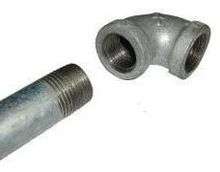
Right: a female threaded elbow
In plumbing fittings, the "M" or "F" usually comes at the beginning rather than the end of the abbreviated designation. For example:
- MIPT denotes Male Iron Pipe Thread;
- FIPT denotes Female Iron Pipe Thread.
A short length of pipe having an MIP thread at both ends is sometimes called a nipple. A short pipe fitting having an FIP thread at both ends is sometimes called a coupling.
Hermaphroditic connections, which include both male and female elements in a single unit, are used for some specialized tubing fittings, such as Storz fire hose connectors. A picture of such fittings appears in § Genderless (hermaphroditic), below.
Downspout
Downspouts (downpipes, rain conductors or leaders) are used to convey rainwater from roof gutters to the ground through hollow pipes or tubes. These tubes usually come in sections, joined by inserting the male end (often crimped with a special tool to slightly reduce its size) into the female end of the next section. These connections are usually not sealed or caulked, instead relying on gravity to move the rainwater from the male end and into the receiving female connection located directly below.
Ductwork
Sheet metal ductwork for conveying air in HVAC systems typically uses gendered connections. Typically, the airflow through a ductwork connection is from male to female. However, since one-way flow is implemented by forced-air fans or blowers, "backwards" gendered connections can be seen frequently in some systems, since all connections are typically sealed with duct sealing mastic or tape to prevent leakage anyway. The flow convention is usually loosely adhered to for simplicity of design, and to reduce the number of gender changer fittings required, but exceptions are made whenever expedient.
Electrical and electronic
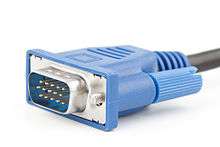
Although the gender of tubing and plumbing fittings is usually obvious, this may not be true of electrical connectors because of their more complex and varying constructions. Instead, connector gender is conventionalized and thus can be somewhat obscure to the uninitiated. For example, the female D-subminiature connector body projects outward from the mounting plane of the chassis, and this protrusion could be erroneously construed as male. Instead, the "maleness" of the D-subminiature connectors is defined by specific presence of male pins, rather than by the protrusion of the connector, which is also true for many other pin-based connectors like XLR. The male/female distinction is more obvious with ring crimp lug connectors which are placed around a screw post, but again with spade or split ring crimp lug connectors the end alone is not obviously female.
Further confusion can be caused by the term "jack", which is used for both female and male connectors and typically refers to the fixed (panel) side of a connector pair. IEEE STD 100, IEEE-315-1975 and IEEE 200-1975 (replaced by ASME Y14.44-2008) define "Plug" and "Jack" by location or mobility, rather than gender.[2][3][4]
A connector in a fixed location is a jack and a moveable connector is a plug.[2][4] The distinction is relative, so a portable radio is considered stationary compared to the cable from the headphones; the radio has a jack, and the headphone cable has a plug. Where the relationship is equal, such as when two flexible cables are connected, each is considered a plug. Jacks use the reference designator prefix of J and plugs use the reference designator prefix of P.[2][4] It is possible in the case of box mounted connectors for the connector to be a receptacle with male pin contacts. In this case the connector is designated a jack (J ref des) regardless of the contact gender because the housing for the contacts is in fact configured as the receptacle even though its mate (the plug) goes around the receptacle. See MIL-STD-38999 and similar cases.
It is common practice to use female connectors for jacks, so the informal gender-based usage often happens to agree with the functional description of the technical standards. However, this is not always the case; often-seen exceptions include a computer's AC Power Inlet and EIA232 DE9 Serial Port, or the male coaxial power jacks for connecting external power adapters to portable equipment.
To summarize, it is considered best practice to use "male" and "female" for connector gender, and "plug" and "jack" for connector function or mobility.
Variant usages
In the UK, many Commonwealth countries and some non-English-speaking countries, the word "jack" may refer to the plug on the end of a removable cable. These connectors were originally referred to as "jack plugs", or plugs intended to be mated with fixed receptacles, or sockets (which North Americans would call "jacks"), but the second word was dropped. This variant usage is in direct contradiction to common usage and official standards in North America.
In the United Kingdom, for example, the connector on the end of a headphone lead is known as a "jack", that plugs into a socket on the main unit. The same generally occurs also in Italy, where the English word "jack" is commonly used to indicate the connector on the end of a headphone lead.
In Romania female connectors are known as "mamă" (mother) and male connectors are "tată" (father).
Abbreviations and alternate terminology
The standard letters "M" and "F" are commonly used in part numbers to designate connector gender. For example, in Switchcraft XLR microphone or hydrophone connectors, the part numbers are denoted as follows:
- A3F = Audio 3-pin Female connector;
- A3M = Audio 3-pin Male connector.
The terms plug, pin, and prong are also often used for "male" connectors, and receptacle, socket, and slot are used for "female" connectors. In many cases these terms are more common than male and female, especially in documentation intended for the non-specialist. These nearly synonymous terms can cause a fair amount of confusion when the designations are shortened in labels.
For example, a female high-density D-subminiature connector with a size 1 shell can be named DE15F or DE15S (see accompanying pictures). Both terms mean the same thing but could be construed to be completely different items. Similarly, a male standard-density D-sub with a size 1 shell can be named DE9M or DE9P; a female standard-density D-sub with a size 2 shell can be named DA15F or DA15S; a male high-density D-sub with a size 3 shell can be named DB44M or DB44P; and so forth.
- Male and female electrical connectors
 A panel-mounted IEC 60320 C14 male connector jack designed to accept AC line power
A panel-mounted IEC 60320 C14 male connector jack designed to accept AC line power A female VGA connector which serves as a jack
A female VGA connector which serves as a jack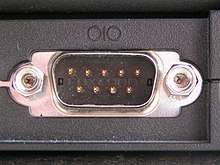 A male DE-9 serial port connector which serves as a jack
A male DE-9 serial port connector which serves as a jack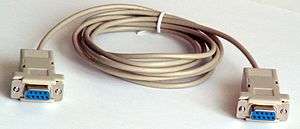 A null modem cable with a female connector on each end, both of which serve as plugs
A null modem cable with a female connector on each end, both of which serve as plugs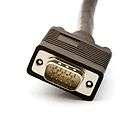 A male D-Subminiature connector which serves as a plug. The pins make this connector male; the surrounding shield does not change that.
A male D-Subminiature connector which serves as a plug. The pins make this connector male; the surrounding shield does not change that.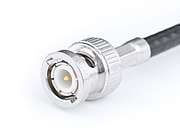 A male 50 ohm BNC connector plug. Three circular projections (including the central pin) interlock with two rings of the female jack.
A male 50 ohm BNC connector plug. Three circular projections (including the central pin) interlock with two rings of the female jack.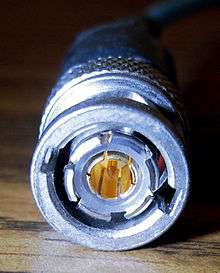 Triaxial BNC connector, a male plug
Triaxial BNC connector, a male plug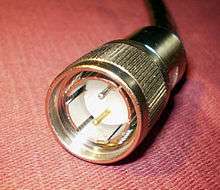 Twinaxial cable connector, a male plug
Twinaxial cable connector, a male plug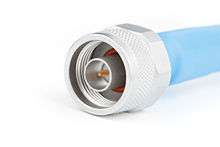 Coaxial Type N connector, a male plug
Coaxial Type N connector, a male plug Female (left) and male weatherproof plugs for photovoltaic solar panels
Female (left) and male weatherproof plugs for photovoltaic solar panels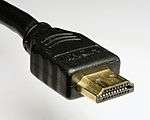 This HDMI plug is conventionally assigned to male gender
This HDMI plug is conventionally assigned to male gender.jpg) Toslink male plug optical fiber connector
Toslink male plug optical fiber connector
Gender selection in electronic design
Electronic designers often select female jack connectors for fixed mounting on electronic equipment they design. This is usually done because female connectors are more resistant to damage or contamination, by virtue of their concealed or recessed electrical contacts. A damaged motherboard connector can result in the scrapping of an expensive piece of electronic equipment. The risk of expensive damage is reduced by relegating the more exposed male contacts to connecting cables, which can be repaired or replaced at lower cost. However, since motherboards have all slot connector positions loaded regardless of how many slots will actually be filled, this would seem to favor the cheaper male connector.
With an RS232 serial port, the male connector is more fragile than the female connector.[5]
Some people say the male coaxial connector is more prone to damage.[6] Other people say the female coaxial connector is more prone to damage.[7][8]
Such cost and reliability considerations probably drove the design decision to use female jack connectors on many computer terminals (and some personal computers) for the serial port, in direct violation of the connector gender convention specified in the RS-232 standard for "DTE" computer equipment. This confusing reversal of the RS-232 connector gender convention would cause many hours of frustration for ill-informed end users, as they tried to troubleshoot non-functional serial port equipment connections.
In the case of electrical power connections, designers do not reverse connector gender in such a casual fashion, because exposing live AC line power on male connectors is unsafe and generally illegal. Devices that need to be robust against mechanical damage use a special male IEC 60320 C14 connector (see Gallery above), which is recessed below the surface of a mounting panel, providing the desired physical protection while conforming to safety regulations.
Safety
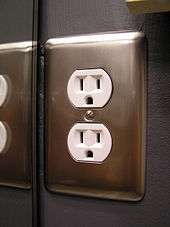
In electrical connections where voltage or current is sufficient to cause injury, the part permanently connected to the power source is invariably female, with concealed contacts, to prevent inadvertent touching of live conductors. A male plug, with fully exposed protruding contacts, is installed on the cord of (or directly onto) the device receiving the power.
In the case of consumer-level AC power, connector gender is used to implicitly enforce safe use of power connectors. Because of this consideration, it is illegal under electrical code to make or use any gender changers to connect AC line power to consumer-level equipment.
In low-voltage use such as for data communications, electrical shock hazard is not an issue, and male or female connectors are used based on other engineering factors such as convenience of use, cost, or ease of manufacturing. For example, the common "patch cables" used for Ethernet (and the similar cords used for telephones) typically have male modular plugs on both ends, to connect to jacks on equipment or mounted in walls.
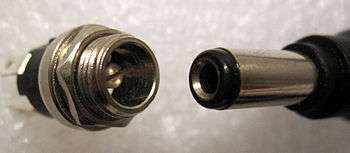
As an illustrative example of some design tradeoffs in power connector selection, consider the adjacent picture. A commonly seen coaxial power connector is usually set up so that power is fed from the female plug on the right into the male jack on the left (which is typically a part of the electronic device accepting the power). Although the plug is female, with a partially recessed center contact, it is still possible for casual accidental contact with a metallic object to short-circuit the power source. Depending on the design of the power adapter, it may react to a short circuit by shutting down temporarily, or instead by blowing out an internal safety fuse.
In this example, the marginal reliability of the connector choice was deemed to be acceptable by the equipment designer, since the power adapter supplies low voltage that does not pose an electric shock hazard. The potential fire hazard from accidental short-circuiting is addressed by the internal safety fuse, although this requires that a failed power adapter must be completely replaced. In a different design, if the power adapter were intended to supply a voltage sufficient to cause electrical shock, the semi-exposed center contact of the female plug would be considered unacceptably hazardous, requiring a different choice of power connector.
Ambiguous gender
Some electrical connectors are hermaphroditic because they include both male and female elements in a single unit intended to interconnect freely, without regard for gender. See the discussion of Genderless connectors elsewhere in this article for more detailed information.
As an additional complication, certain electronic connector designs may incorporate combinations of male and female pins in a single connector body, for mating with a complementary connector with opposite gender pins in corresponding positions. In these unusual cases, gender is often defined by the shape of the connector body, rather than the mixed-gender connector pins and sockets. These types of connectors are not strictly speaking hermaphroditic, since mating connectors are not freely interchangeable. An informal term that has been used for these connectors is "bisexual", in addition to the more official terminology, mixed-gender. Thus, for example, one can have a mixed-gender female plug that connects to a mixed-gender male jack (though a reversed gender assignment of connectors would be a more typical design choice in this example).
Male connector pins are often protected by a shell (also called a shroud, surround, or shield), which may envelop the entire female connector when mated. RF connectors often have multiple layers of interlocking shells to properly connect the shields of coaxial and triaxial cable. In such cases, the gender is assigned based on the innermost connecting point. With the exception of reverse polarity BNC or TNC, where the outer shell determines the gender and the innermost connecting points are opposite to a standard connector, for example a female RP-TNC connector has a solid innermost pin.
Another ambiguous situation arises with the connectors used for USB, FireWire (IEEE-1394), HDMI, and Thunderbolt serial data bus connections. Close examination of these connectors reveals that the contact "pins" are not actually pins, but instead are conductive surfaces that slide past each other when they mate. Therefore, the traditional pin and socket nomenclature is not applicable. Instead, most computer hardware people fall back to referring to the wrap-around metal shield on the plug connector as if it were a connector pin. By this convention, the connectors on serial bus cables are "male plugs", and the corresponding connectors on equipment are "female jacks". A unique connector configuration where the contacts are hermaphroditic is the ELCO Varicon where the contacts are bifurcated and nest with one another axial at a 90 degree rotation in cross-shaped wells. In this case the plugs had the contacts oriented transversely and the sockets longitudinally.
A casual glance at a USB "Type A" plug connector may give the false impression that it is hermaphroditic. However, a physical attempt to mate two USB "Type A" cables with each other reveals the fact that the connectors will not interconnect. Classifying according to mathematical graph theory, USB buses are directed trees, whereas FireWire buses have a true bus network topology. This difference is reflected in the bus connectors used, in that USB cables are asymmetrical (one end Type A, other end Type B) while FireWire cables may have identical connectors at both ends.
Genderless (hermaphroditic)
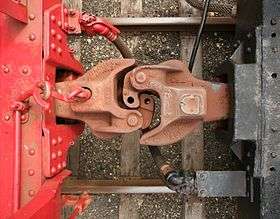
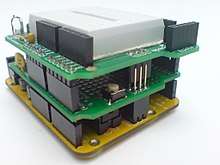
By definition, a hermaphroditic connector includes mating surfaces having simultaneous male and female aspects, involving complementary paired identical parts each containing both protrusions and indentations. These mating surfaces are mounted into identical fittings which can freely mate with any other, without regard for gender (provided that the size and type are already matched). Alternative names include hermaphrodite, androgynous, genderless, sexless, combination (or combo), two-in-one, two-way, and other descriptive terms. Several of these latter alternate names are ambiguous in meaning, and should not be used unless carefully defined in context. True hermaphroditic connectors should not be confused with mixed gender connectors, which are described elsewhere in this article.
Another closely related type is the stackable connector for electronics, which typically has male pins on one surface, and complementary female sockets on the opposite surface, allowing multiple units to be stacked up like plastic milk crates. Examples of this include stackable banana plugs, and interconnect cables specified for the IEEE-488 instrumentation bus. Stackable mezzanine bus connectors are used on some modular microcomputer accessory boards for systems such as the Arduino add-on daughterboards called "shields". The older PC/104 embedded PC modules use a similar stackable format for interconnection. Stackable connectors are not classified as hermaphroditic in the strictest sense, but are often described as such in looser usage.
The hermaphroditic design is useful when multiple complex or lengthy components must be arbitrarily connected in various combinations. For example, if hoses have hermaphroditic fittings, they can be connected without having to pull a lengthy hose and reverse it because it has the wrong gender to connect to another hose. Some military fiber optical cables also have hermaphroditic connectors to prevent "wrong gender" connector problems in field deployments. In a similar fashion, railcars are usually equipped with hermaphroditic railway coupling mechanisms that allow either end of the vehicle to be connected to a train without having to turn the railcar around first. For the same reason, several spacecraft docking mechanisms are designed to be "androgynous", including the Androgynous Peripheral Attach System, the NASA Docking System, and Chinese Docking Mechanism.
In the absence of genderless connectors, gender changer fittings might be used to enable certain connections. The designer of a connection system may use one or both schemes to allow arbitrary connectivity, or even combine both schemes into a single system.
When an enforced sense of unidirectionality or "one-way flow" is required for safety or other reasons (for example, AC electrical power connections), a strict assignment of connector genders is implemented to prevent undesired configurations, and gender changers are banned.
Some commonly seen examples of hermaphroditic connectors include the SAE connector for 12 V DC power, jackhammer air hose connectors, and the Anderson Powerpole series of modular high-current power connectors. The IBM token ring connector was another widespread example, but it has become obsolete and is being phased out. The General Radio Corporation developed a hermaphroditic coaxial radio frequency connector often called the "GR connector".
Some audio multicore cables are fitted with hermaphroditic multipin quick-disconnect connectors for ease of use in the field. One style of this audio signal cable is fitted on both ends with connectors that are each populated half with pins and half with sockets. The advantage to the user is that it does not matter which end connects to the stage and which to the audio mixer, facilitating faster set up.[9] Another style of connector uses hybrid male/female pins with a receiving slot fitted in the center of each two-tine pin, and relies on 90-degree rotation of the pin axes to mate. The connector housings themselves are sexed male and female.[10]
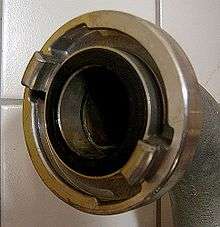
- Hermaphroditic or genderless "claw" type hose connectors
- IBM token ring hermaphroditic connector with locking clip
 SAE hermaphroditic connector used for 12 V DC power
SAE hermaphroditic connector used for 12 V DC power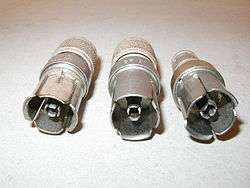
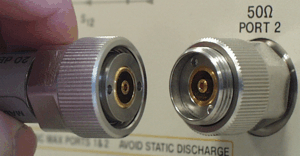
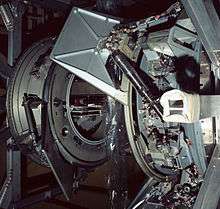 Androgynous Peripheral Attach System spacecraft docking mechanism
Androgynous Peripheral Attach System spacecraft docking mechanism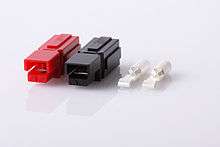 Anderson Powerpole 15/30/45 ampere genderless housings and contacts
Anderson Powerpole 15/30/45 ampere genderless housings and contacts
Gender changers
Devices used for mating two connectors of the same gender have a wide variety of terms, including for example: "gender changer", "gender mender", "gender bender", and "gender blender".[11] A specific gender changer can be referred to by either the gender of its connectors, or the gender which it is designed to connect to, resulting in a thoroughly ambiguous terminology. Thus a "male gender changer" might have female connectors to mate two male ends, or male connectors to mate two female ends.
Adding to this potential for confusion, some gender changers also combine additional functions such as cross-over pin-outs or even embedding micro-controllers for performance, or for logic level or protocol adaptations, which would properly make them an adapter, but this nomenclature is sometimes neglected in marketing materials or common parlance.
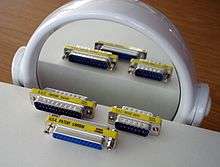 DA15 and DB25 D-subminiature gender changers
DA15 and DB25 D-subminiature gender changers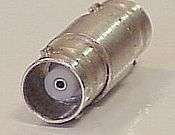 A female to female BNC connector
A female to female BNC connector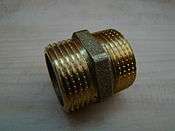 Pipe nipple male to male threaded pipe coupling
Pipe nipple male to male threaded pipe coupling
Examples
- Coaxial power connector, for low voltage DC connections
- A power cord on an appliance terminates in a (male) plug; it connects to a (female) socket in a wall or on an extension cord.
- Coaxial cables used for video or other high-frequency signals are normally terminated, at both ends, in a connector comprising an inner pin and an outer fixed or rotating shell; these are conventionally reckoned as male.
- A threaded nut is female and a bolt is male.
- Connectors for air brake hoses on heavy trucks and railroad equipment use genderless "gladhand connectors". In railroad air brake use, this makes the orientation of rolling stock irrelevant, and is used with the standard North American railroad coupler that connects cars together, also genderless.
- The Talmud describes arrow heads and mating shafts as potentially being either male or female, depending on their construction, i.e. a prong on a male arrow head fits into a hollowed out shaft and vice versa. This is owing to a prohibition on a female shaft, from its susceptibility as a receptacle for impurity, for use as s'chach[12]
See also
- Mating connection
- Piping and plumbing fittings
- Screw thread
- Sex bolt
- Twistlock – standardized fasteners for shipping containers
References
- Huggins, John S. (15 July 2009). "Jack/Plug – Jack, Plug, Male, Female Connectors". An Engineer's Review. Retrieved 1 July 2019.
- Graphic Symbols for Electrical and Electronics Diagrams (including Reference Designation Letters). IEEE. 1975.
- Standard Reference Designations for Electrical and Electronics Parts and Equipments: IEEE-200-1975 (Reaffirmed 1988): Section 4.1.5.3. IEEE and ANSI, New York, NY. 1975.
- Reference Designations for Electrical and Electronics Parts and Equipment: ASME Y14.44-2008 : Section 2.1.5.3 (2). ASME, Fairfield, NJ. 2008.
- Roedy Green. "RS-232C".
- Michael Jay Follingstad, Jeffrey Louis Peters. "US 5967852 A: Repairable connector and method". 1998. quote: "prone to damage".
- Ross Van Woert. "Male Front-Panel Connectors on Millimeter-Frequency Instruments: Why?". quote: "the male connector is generally more physically robust than the female."
- Bill Oldfield. "The Importance of Coax Connector Design Above 110 GHz". 2014.
- Live Sound International. Archives, April 2003. Connect Corner: The ins and outs of multipin connector designs. Peter Janis, Cabletek.
- "EDAC. 516 Series Plug & Receptacle Rack & Panel Connectors with EDACON Hermaphroditic Contact Mating Design". Archived from the original on 2009-02-26. Retrieved 2008-09-30.
- Jargon File: gender mender
- Goldwurm, R. Hersh, Ed. Talmud Bavli: Tractate Sucah I, Schottenstein Edition. Brooklyn, NY: Mesorah Publications Ltd.Gemara p.12b